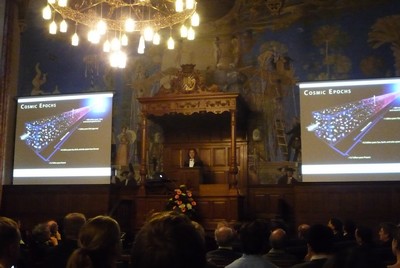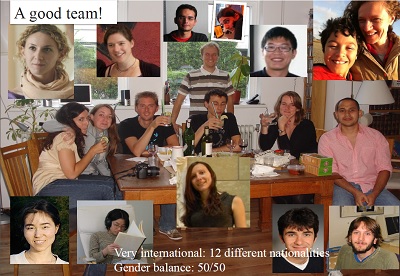So many stars, so few women
On 11 November, University of Groningen astronomer Amina Helmi held her inaugural lecture as Professor of Dynamics, Structure and Evolution of the Milky Way. She shared her fascination for the Milky Way with her audience in the Academy Building, but also her worries about the low number of women at the top of the university hierarchy.

Helmi’s work can be described as ‘galactic archaeology’. Her focus is on the evolution of our own Milky Way: how did it become what it is today? That’s not just a parochial interest, she explains: ‘We live in a very average galaxy, so if we study the history of the Milky Way, we learn about the evolution of some two thirds of all galaxies.’
What Helmi does is analyse the movement and composition of stars. The composition tells you something about their age, and from the movement it is possible to deduce where a star has come from.
The dominant model for galaxy evolution is that of mergers: big galaxies like our own have grown from the merger of many small galaxies. Helmi has identified groups of stars with a shared history (similar age and direction of movement). Such ‘streams’ are most likely the remnants of a merger.
The movement of stars, especially in the halo of the Milky Way, also tells us something about dark matter, the invisible stuff that probably makes up nearly a quarter of all the mass in the Universe. Dark matter is inferred by the speed at which stars move. ‘We can calculate the mass of a galaxy and then predict how fast the stars should move. What we find is that the stars move too quickly for the amount of mass we can see.’ The explanation: a halo of unseen dark matter that adds to the mass of the galaxy.
Helmi is one of the lead investigators of the Gaia mission that will measure the movement and composition of a billion stars. ‘We now have such data from a tiny part of the Milky Way. Gaia will increase the volume for which we have accurate data on stars by a million.’ The Gaia satellite was launched in December 2013 and produces fifty gigabytes of data each day.

‘But to study all this, I need a good team’, says Helmi after her remarks on past, present and future research. She leads one of the biggest research groups in the University’s Kapteyn Institute for Astronomy. A photo of her dream team shows lots of faces. ‘There are twelve nationalities, and the gender balance is about 50/50’, Helmi adds.
That brings her to the final part of her lecture. Why is it that the number of women decreases as you rise through the University’s hierarchy? Women make up just 10 percent of all professors. ‘And that is typical for the Netherlands.’ Her own country, Argentina, is often associated with macho culture, but has a higher percentage of female professors than the Netherlands.

She also points to the male domination in professional orchestras in the seventies. ‘The solution then was to hold blind auditions. That rectified the gender balance.’ Of course, Helmi acknowledges, this is difficult to implement for academic job vacancies, but it should make us aware of the biases that abound.
Helmi has one more point to make: ‘We need substantial investment and intellectual freedom to pursue fundamental scientific research.’ Immediate return on investment is not always possible: good things can take time. Take the fundamental research of Niels Bohr on quantum theory. She ends her talk with a call for support for true innovation and critical thinkers.
Text and slides of the inaugural lecture are available online .
| Last modified: | 14 May 2020 09.25 a.m. |
More news
-
10 June 2024
Swarming around a skyscraper
Every two weeks, UG Makers puts the spotlight on a researcher who has created something tangible, ranging from homemade measuring equipment for academic research to small or larger products that can change our daily lives. That is how UG...
-
21 May 2024
Results of 2024 University elections
The votes have been counted and the results of the University elections are in!

